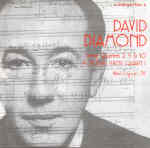For pure craft and fluidity there’s nothing about the string quartet medium that David Diamond didn’t master. Volume 2 in Albany’s Diamond Quartet cycle opens with Quartet No. 2 from 1943. Notice the ease and elegance with which the spiraling, asymmetrical theme and signpost scales pass back and forth among the four players. The same holds for the finale’s assertive, motoric counterpoint. That said, I find the work comparatively academic and dry next to the gutsy demeanor and melodic ardency of Diamond’s subsequent Third Quartet (available on Volume 1).
The Ninth and Tenth Quartets date from the mid- to late ’60s, when the composer’s style had taken dissonant, leaner, and darker turns, achieving expressive gains in the process. No. 9 is particularly striking for its eerie chains of trills, which the Potomac players shade with the subtlest calibration they can muster. The ensemble displays amazing tonal and dynamic control over the long, aching lines in No. 10’s Lento while digging vigorously into the fast, jagged interruptions. And the players perfectly time the slow transition into the concluding double fugue while keeping the fugue’s tricky rhythmic components perpetually clear and characterful. Special mention should be made of violist Tsuna Sakamoto’s rich, vibrant sonority in the slow movements of the Second and Tenth Quartets. In addition to superb engineering, Albany’s annotations include invaluable interviews with Diamond that focus on these specific works. Recommended with enthusiasm. [11/29/2003]
































